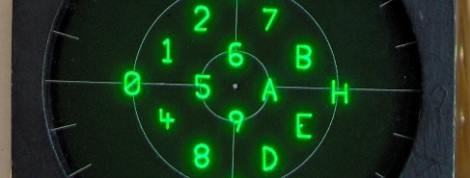
The cockpit of an F-16 Fighting Falcon features a small 3-inch display that monitors and tracks hostile aircraft and missiles, friendlies, and the current target. This Radar Warning Receiver is vitally important to pilots in combat, so [Mike] decided to add one to his homebuilt F-16 simulator that runs Falcon 4.0.
The RWR displays threats as symbols that are usually generated by tens of thousands of dollars worth of military hardware. [Mike] figured a $7 PIC microcontroller would work just as well and set about designing vector graphics that would fit on a single chip.
[Mike] had the graphics displaying correctly on an oscilloscope, but that’s a far cry from the from the surplus RWR display he picked up. Although the display is a simple CRT, the original designers of the radar warning receiver thought it necessary to put the deflection amplifiers in another part of the airplane. After building a pair of 30 Watt amplifiers, [Mike] could finally display more than a single dot on the display.
After all was said and done, [Mike] has a wonderful radar warning display that fits into his F-16 cockpit perfectly. While it’s not quite a 737 in a garage, we’ve got to respect someone who takes surplus avionics and makes them work. Check out [Mike]’s display in action after the break.
[youtube=http://www.youtube.com/watch?v=yKg11SHZZ5A&w=470]















This would make a great screen for asteroids or battlezone :)
Nice job!
No, Gyruss!
Very cool! Wonder why they felt the need to put the deflection amplifiers elsewhere… there’s got to be a story there.
Nicely done!
The indicator was part of the AN/ALR-46 radar warning receiver. The deflection amplifiers were in the Signal Processor. The symbols were in ROM, which could be modified to display funny messages during power up. The “threat tables” were also in ROM until the mid-80’s, when we upgraded to EE-Proms. No more paper tape and manually burning ROMS! Along with the CRT display was another box called a “TDU” which had the volume control and status indicators. There was an advanced version called an AN/ALR-69 (it was in F-16’s).
The ALR-69 is used in the heavy world as well, we have it on our C-130Hs
Seems to be some visible tracing artifacts where the ray is guided from one symbol to the other. Is this visible on the real thing?
Ah, found the answer:
“We still need to get the blanking signal working. That will remove the faint lines connecting the symbols as well as ….”
@Rob, why put def amp elsewhere? Prolly either 1) conserving cubic inches in the cockpit and/or 2) putting an assembly deemed more likely to fail into the avionics bays, where they can be easily yanked and sent to depot for rework.
i agree, …
every serviced (cough: upgrade) the stereo in a BMW car???
you have to disassemble EVERYTHING before you can even THINK about removing the stereo, sounds like a simillar story.
service bay would probably be a 30 second job.
then again, ive never serviced a military F-16 so i wouldnt know :P
Wow you flight sim folks really do the mods up right :) Nice job getting everything figured out and glad it all works :)